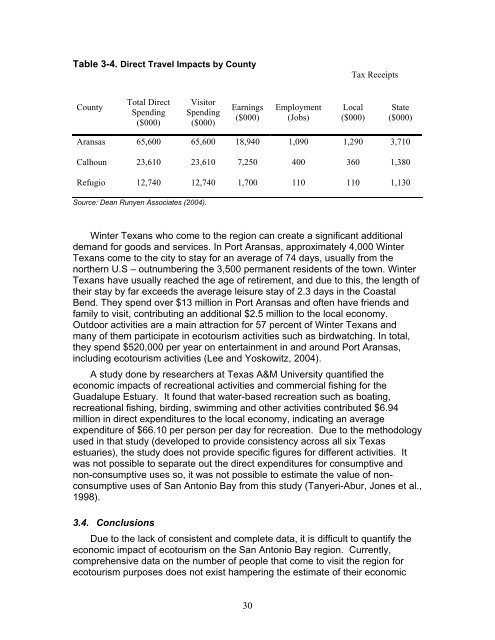The Economic Value of Water and Ecosystem Preservation
The Economic Value of Water and Ecosystem Preservation
The Economic Value of Water and Ecosystem Preservation
Create successful ePaper yourself
Turn your PDF publications into a flip-book with our unique Google optimized e-Paper software.
Table 3-4. Direct Travel Impacts by County<br />
County<br />
Total Direct<br />
Spending<br />
($000)<br />
Visitor<br />
Spending<br />
($000)<br />
Earnings<br />
($000)<br />
30<br />
Employment<br />
(Jobs)<br />
Tax Receipts<br />
Local<br />
($000)<br />
State<br />
($000)<br />
Aransas 65,600 65,600 18,940 1,090 1,290 3,710<br />
Calhoun 23,610 23,610 7,250 400 360 1,380<br />
Refugio 12,740 12,740 1,700 110 110 1,130<br />
Source: Dean Runyen Associates (2004).<br />
Winter Texans who come to the region can create a significant additional<br />
dem<strong>and</strong> for goods <strong>and</strong> services. In Port Aransas, approximately 4,000 Winter<br />
Texans come to the city to stay for an average <strong>of</strong> 74 days, usually from the<br />
northern U.S – outnumbering the 3,500 permanent residents <strong>of</strong> the town. Winter<br />
Texans have usually reached the age <strong>of</strong> retirement, <strong>and</strong> due to this, the length <strong>of</strong><br />
their stay by far exceeds the average leisure stay <strong>of</strong> 2.3 days in the Coastal<br />
Bend. <strong>The</strong>y spend over $13 million in Port Aransas <strong>and</strong> <strong>of</strong>ten have friends <strong>and</strong><br />
family to visit, contributing an additional $2.5 million to the local economy.<br />
Outdoor activities are a main attraction for 57 percent <strong>of</strong> Winter Texans <strong>and</strong><br />
many <strong>of</strong> them participate in ecotourism activities such as birdwatching. In total,<br />
they spend $520,000 per year on entertainment in <strong>and</strong> around Port Aransas,<br />
including ecotourism activities (Lee <strong>and</strong> Yoskowitz, 2004).<br />
A study done by researchers at Texas A&M University quantified the<br />
economic impacts <strong>of</strong> recreational activities <strong>and</strong> commercial fishing for the<br />
Guadalupe Estuary. It found that water-based recreation such as boating,<br />
recreational fishing, birding, swimming <strong>and</strong> other activities contributed $6.94<br />
million in direct expenditures to the local economy, indicating an average<br />
expenditure <strong>of</strong> $66.10 per person per day for recreation. Due to the methodology<br />
used in that study (developed to provide consistency across all six Texas<br />
estuaries), the study does not provide specific figures for different activities. It<br />
was not possible to separate out the direct expenditures for consumptive <strong>and</strong><br />
non-consumptive uses so, it was not possible to estimate the value <strong>of</strong> nonconsumptive<br />
uses <strong>of</strong> San Antonio Bay from this study (Tanyeri-Abur, Jones et al.,<br />
1998).<br />
3.4. Conclusions<br />
Due to the lack <strong>of</strong> consistent <strong>and</strong> complete data, it is difficult to quantify the<br />
economic impact <strong>of</strong> ecotourism on the San Antonio Bay region. Currently,<br />
comprehensive data on the number <strong>of</strong> people that come to visit the region for<br />
ecotourism purposes does not exist hampering the estimate <strong>of</strong> their economic
















